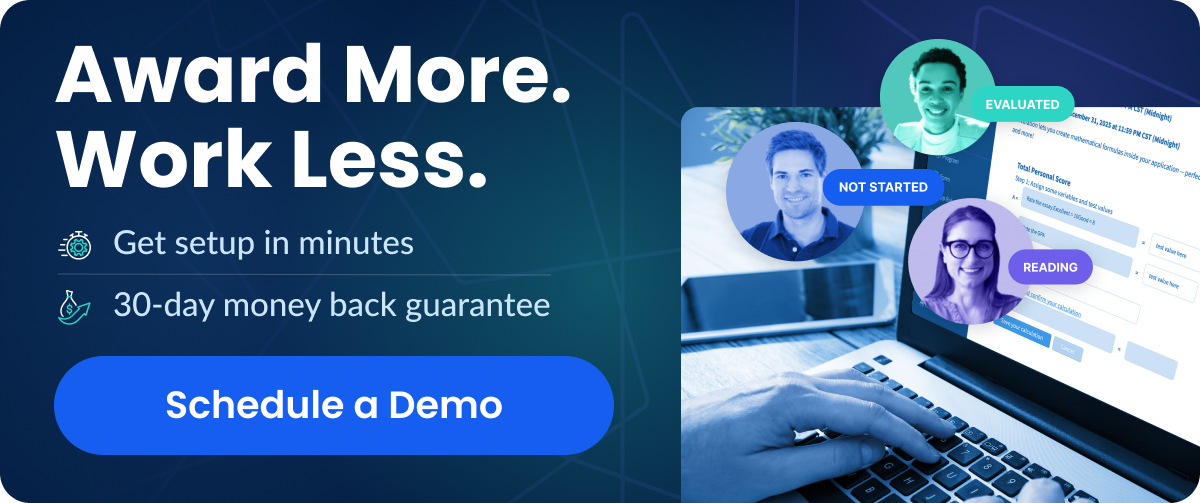5 Best Practices for Scholarship Administration
Scholarship administration involves the end-to-end process of managing scholarship programs – from determining award criteria to selecting recipients and disbursing funds. With many moving parts and stakeholders, implementing scholarship administration best practices is critical for success.
In this post, we’ll explore the five best practices for scholarship administration. Following these best practices allows scholarship administrators to create seamless, equitable, and streamlined programs. They enhance efficiency, accuracy, and transparency across the scholarship lifecycle. Students benefit from a smooth application experience and selection process. Reviewers can easily evaluate applicants. Admins gain invaluable time and insights.
Before we get to those best practices though, let’s take a closer look at what scholarship administration involves, shall we?
What Is Scholarship Administration?
Scholarship administration refers to the overall management of scholarship programs, which can include elements such as:
- Establishing scholarship criteria and guidelines: Determining who is eligible for the scholarship, the award amount, application requirements, selection process, etc.
- Promoting the scholarship opportunity: Getting the word out so potential applicants are aware of the scholarship and application details.
- Collecting applications and materials: Providing a way for candidates to submit applications and required documents/information. This often involves an online application form.
- Evaluating applicants: Reviewing applications, scoring, ranking, and selecting scholarship recipients based on established criteria. Often involves a selection committee.
- Notifying recipients: Contacting scholarship winners and non-winners to share decisions.
- Disbursing funds: Ensuring scholarship funds are paid out to cover recipients' tuition, fees, or other designated expenses.
- Stewardship and reporting: Keeping donors and stakeholders informed about the impact of the scholarships. Maintaining relationships with recipients.
Effective scholarship administration requires clear processes, organization, transparency, and communication. This leads us to the five core best practices that can help scholarship administrators execute programs successfully year after year.
What are the 5 Best Practices for Scholarship Administration?
The top five best practices for scholarship administration are:
- Clear and transparent guidelines
- Efficient application and selection process
- Fair and impartial evaluation
- Timely communication
- Stewardship and reporting
Now that you know what they are, let’s break them down further so you can take your management game to the next level.
1. Clear and Transparent Guidelines
The first best practice for scholarship administration is having clear and transparent guidelines. All details about the scholarship program should be readily available to potential applicants.
Clearly communicate eligibility criteria such as:
- GPA requirements
- Financial need qualifications
- Field of study
- Enrollment status, and
- Any other factors that determine who can apply.
Make sure this information is easy to find on your website, printed materials, and application portal.
Scholarship value and number of awards are also key details to share upfront. Be explicit about whether it’s a one-time or renewable award, and how funds will be disbursed (lump sum or by term).
Explicitly state required application materials and deadlines for submission as well. Items like essays, recommendation letters, academic records, portfolios, or interviews should be outlined. Format specifications, length requirements, and any other expectations should be defined.
Finally, inform applicants of selection processes and timeline. For example, notify if selection involves a committee review or interviews. Provide expected notification dates so applicants can plan accordingly.
Being transparent about guidelines upfront allows applicants to self-evaluate their fit and preparation for the scholarship. This minimizes submissions from unqualified students and ultimately streamlines your administration and evaluation.
Strive to make all scholarship details available in one centralized location. This improves findability and prevents confusion. Review the guidelines regularly to ensure accuracy. Update any changes such as deadlines immediately.
2. Efficient Application and Selection Process
An efficient application and selection process is critical for smooth scholarship administration. What does this look like in practice?
First, make applying as simple as possible for candidates. Use an online portal with smart form logic to simplify submissions such as SmarterSelect. It’s also a good idea to use pre-screening to automatically determine initial eligibility, and allow file uploads versus mailing hard copies of application materials.
Leverage technology to review applications and instantly disqualify ineligible or incomplete submissions. This alleviates administrative burden. Automated scoring features can also identify top applicants for further review.
For selection, establish a formal review committee with diverse stakeholders like faculty, alumni, or community members. Share applications and materials with reviewers through a secure online platform.
Create a structured review process with clear evaluation criteria based on scholarship objectives. Use standardized rubrics for consistent assessment and ratings across reviewers.
Schedule in-person meetings strategically. For example, convene only once reviewers have independently evaluated applicants. Then, get together to discuss high potential candidates.
Set clear selection timelines with target dates based on deadlines like acceptance notifications. Track status in real-time to keep the process moving.
Automate administrative tasks like notifications to minimize staff workload post-selection. Customizable templates allow efficient communication at scale.
3. Fair and Impartial Evaluation
Ensuring fair and impartial evaluation of scholarship applications is essential. This builds trust and preserves the integrity of the program.
To be fair and impartial, it’s critical you establish a committee of reviewers with diverse backgrounds related to the scholarship criteria. Seek balance across academics, professionals, community members, and other stakeholders.
Train reviewers on unconscious bias and impartial review techniques. Provide resources to recognize and mitigate any biases.
Use blind review techniques such as anonymizing applications and documents. Mask identifying details like name, gender, age, and background. Reduce bias towards factors irrelevant to set criteria.
Implement standardized evaluation rubrics and consistent rating scales. Require reviewers to substantiate ratings with evidence from the application versus instinct.
Compare reviewer scores and feedback to identify any outliers or inconsistencies. Additional discussion or independent readings may be necessary to resolve divergent perspectives.
Collect feedback from both reviewers and applicants on fairness. Look for concerning trends around bias, misalignment with guidelines, or inequitable treatment of candidates.
Continuously review selection rates by demographic factors like gender, ethnicity, school, etc. to determine if certain groups are disproportionately represented.
Regular evaluation audits are a good idea as well to help with identifying issues early. Ultimately, upholding fairness and impartiality protects the recipients, reviewers, and administrators alike.

4. Timely Communication
Timely and clear communication is paramount in scholarship administration. Applicants await decisions eagerly, so timely updates build goodwill and trust.
First, set applicant expectations upfront by publishing your program’s selection timeline and notification plans. Be clear if notifications will occur by date, batch, or rolling basis.
Automate email notifications through a scholarship management platform such as SmarterSelect. Customizable templates allow efficient outreach at scale. Send confirmations when applications are submitted, received, or if information is missing.
Once decisions are made, immediately notify both recipients and non-recipients. For recipients, include clear next steps (i.e. acceptance forms or verification requirements). Then, follow up individually if administrative tasks are pending.
For recipients, provide guidance on public announcement options, scholarship events, social media recognition, and stewardship expectations.
Schedule conversations when possible. These can be in-person, by phone, or video. Continue communication after the initial award notification too. Send reminders on renewing applications for multi-year scholarships. Or share opportunities like exclusive events, mentorships, or networking.
Notify recipients of any changes in disbursement dates, scholarship criteria for future terms, or updates that impact them. Continue the dialogue. It’s also a good idea to issue alerts if recipients are at risk of losing eligibility like GPA requirements. Proactive outreach may allow them to regain good standing.
Ongoing communication and prompt notifications show recipients they are valued. It also keeps applicants, even non-recipients, invested in the program and process.

5. Stewardship and Reporting
Stewardship and reporting help sustain scholarship programs over the long-term. These practices keep donors engaged and demonstrate impact.
First, ensure recipients understand the scholarship source. For example, share background on donors, honorees, or history. Making the connection behind the award fosters gratitude and stewardship.
Provide opportunities for recipient-donor interaction when possible through events, social media, or messages. Direct engagement enriches the experience for both parties.
Ask recipients to complete surveys for feedback on their experience, academic progress, and the scholarship’s impact. Humanize your data by collecting powerful stories and quotes.
Track measurable outcomes like graduation rates, grades, honors, and career progress of past recipients. This helps quantify the scholarship’s impact on tangible success.
Issue public announcements on newly selected recipients through platforms like your website or social media. Recognition motivates future applicants.
Feature student spotlights, videos, and testimonials in stewardship reports. Storytelling makes the figures relatable and memorable.
Visualize data in compelling ways through charts on funding distribution, college acceptance, demographics, or other metrics. Update donors on usage of funds, program growth, recipients’ accomplishments, and feedback regularly as well. Consistent communication nurtures their relationship beyond the initial gift.
Ongoing stewardship provides invaluable insights while strengthening community ties. Powerful reporting sustains programs for the next generation of students.
Conclusion and Next Steps
Implementing these best practices for scholarship administration takes diligence, but doing so pays dividends through optimized programs and engaged stakeholders. From clear guidelines to stewardship, each piece enhances the experience.
Technology plays a powerful role in bringing best practices to life. SmarterSelect provides an end-to-end scholarship management platform to automate and elevate your administration. Our platform centralizes your program guidelines and application in an easy-to-manage portal. Robust tools simplify the submission process for applicants and reviewers alike.
Built-in eligibility checking and machine learning quickly weed out unqualified applicants to focus your efforts. Collaboration features empower your selection committee to evaluate candidates impartially.
Automated notifications keep applicants informed through every stage, ensuring a transparent process. Stewardship capabilities allow you to showcase recipients and connect them with donors.
Rich analytics provide visibility into performance metrics so you can continuously improve the program and process. All while driving efficiencies that give your team time for more strategic initiatives.
With SmarterSelect, best practices are baked into the technology. You can drive fairness, transparency, speed, and engagement across the scholarship lifecycle.
See for yourself how SmarterSelect enables award-winning administration. Request a demo today!



